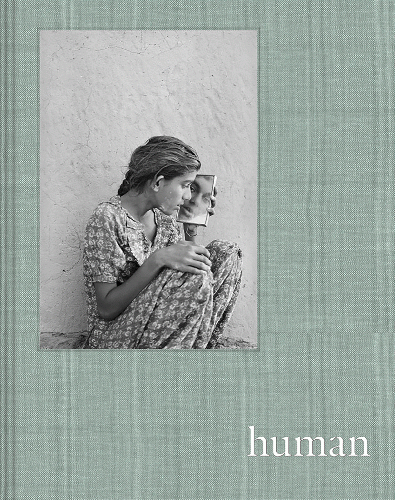Human Conditionals: The Girl Who Looked in the Mirror of the World
by John Kendall Hawkins
Who is this girl with the bleak mirror looking away?
I rorschach (verb); haruspicate the intestines of the clouds. I see no hope. Something stirs as I 'read' the cover photo of Human: Andrew Wyeth's "Christina's World" comes to mind. Something darker is conjured up: Dorothy Lange's Migrant Mother of the Dust Bowl era. Who is this girl with the mirror, head tilted as if she were listening to a portable radio playing the Delta Blues?
The girl is not facing the camera; we see a fraction of her face only through the mirror. The mirror is, seemingly, the focus-locus of the frame. Mirrors are ancient. The mirror is one of the oldest human inventions, dating back to at least 6000 BC. That means mirrors are at least 8000 years old. The earliest mirrors were made of polished obsidian. They have been used for grooming and for magic. And for old reflex cameras. Today you can use your webcam as a mirror. Look how far we've come.
The girl is Jannat (1999 - 2007). She is one subject in a collection of frames by Delhi based photographer Gauri Gill, who toured villages in India, visiting schools, in 1999 (ongoing) and, in a village called Barmer, came across Jannat and her family, and Gill decided to chronicle their plight. On her website, Gill notes: "This series which includes photographs and textual artifacts is based upon the life of a young girl (Jannat), and her small and imperiled family of three, living in a remote hamlet in rural Rajasthan." Gill has exhibited within India and internationally. In 2011, Gill won the Grange Prize, Canada's foremost award for photography.
Gill's experience has been extensive, elaborate and varied. In her Pictet artist's statement for Notes from the Desert, from which Jannat is drawn, she writes,
I have followed the farming cycle, migration, men traveling to work in Gujarat and Maharashtra, Food for Work programmes, MNREGA and other government schemes, nomadic journeys, epidemics, cerebral malaria, tuberculosis, overwhelmed hospitals and understaffed schools, death from snakebite, from accidents, from being burned alive for providing an inadequate dowry, from growing old, the death of a camel in a year remembered as the year of the death of the camel, births, marriages, child marriages, moneylenders, dharnas, national and panchayat elections, festivals, feuds passed down over generations, celebrations, prayers ... and, through it all, my friends, by whom I was led.
She describes her work as not so much journalism or cataloging but as being there with "active listening." She is not there to judge or to preen her preconceptions.
Jannat with the mirror is the cover image of Human, a collection of 100 images competing for Prix Pictet's top photography award for 2023. The book is published by the Pictet Group, whose mission is "to harness the power of photography - all genres of photography - to draw global attention to issues of sustainability, especially those concerning the environment." The award is theme-based, and past foci have included: Fire (2021), Hope (2019), Space (2017), Disorder (2016), Consumption (2015), Power (2014), Growth (2010), Earth (2010), Water (2008). Humans are composed mostly of water, so it makes sense to begin there and to discuss and depict that crisis first.
Human, the 10th cycle, is intent on taking stock of our doings, cumulatively, at a time when the meaning of being human in the anthropocene era has never been more crucial to an understanding of how humans will survive into the future. We have not a crisis in the humanities but crises. Pictet tells us,
As the most dominant species on Earth, humans shape and are shaped by the world around us. The Human theme allows photographers to delve into the vast spectrum of human experiences, emotions, relationships, and challenges that define our collective existence.
Publisher Hatje Cantz adds,
It would be easy to read the human story as one of tragic hubris. Yet it does not end here. We stand on the threshold of the future wondering which way the dice will fall. Our wager with posterity is that human ingenuity, intelligence, and resilience of spirit are powerful enough to insist upon a very different future for the human story.
(Note: You can view every article as one long page if you sign up as an Advocate Member, or higher).





